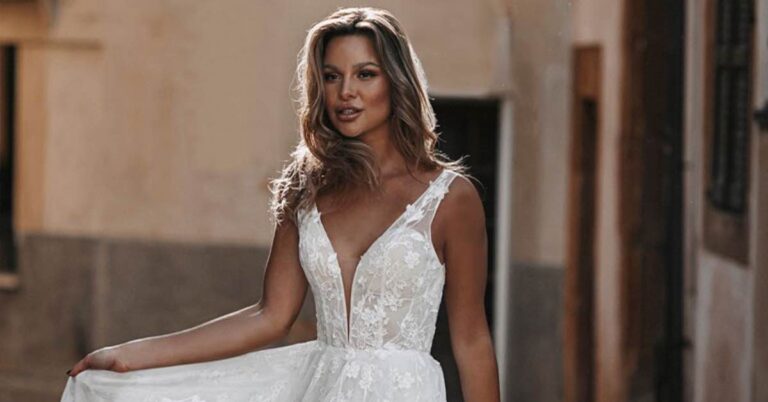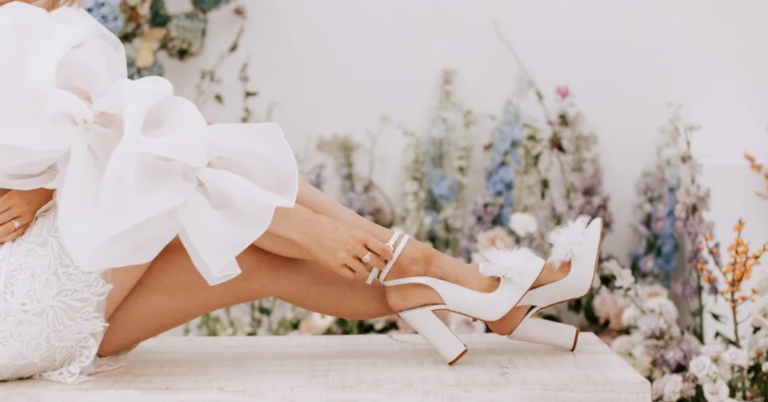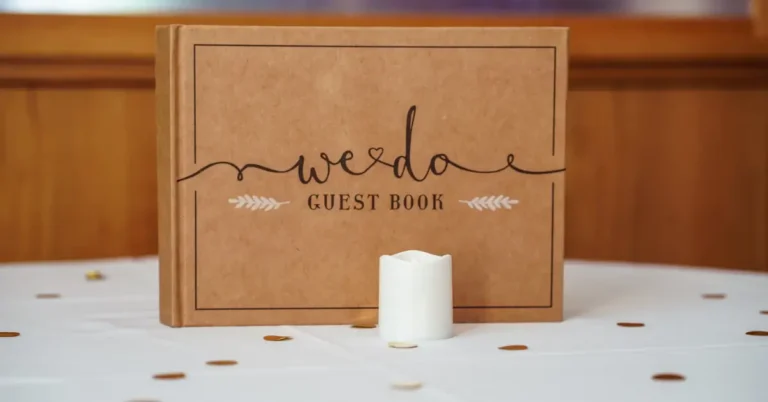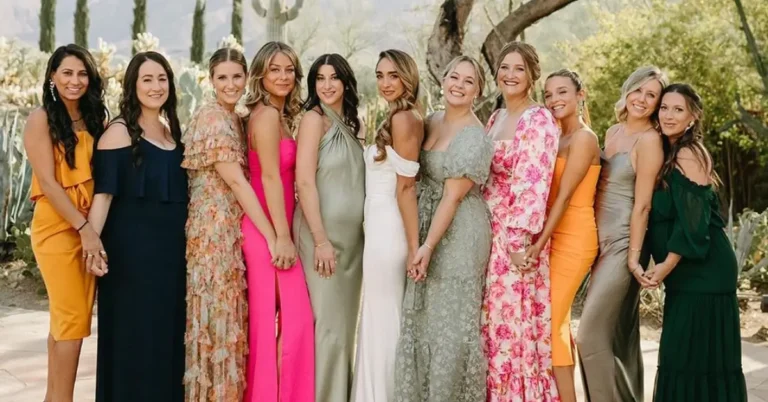A wedding gown from Japan represents the essence of tradition, grace, and profound cultural roots. Picture yourself beneath the cherry blossoms, enveloped in the elegance of a traditional kimono or a modern white bridal gown, each meticulously crafted to honor the heritage of Japanese artisanship. This fusion of timeless and contemporary elements produces a breathtaking visual display.
Whether you opt for a traditional Shinto ceremony or a blend of Western and Japanese styles, the Japanese wedding dress embodies grace and tradition. Each fabric, color, and pattern tells a story, reflecting Japan’s rich heritage.
Ready for a cultural and sartorial adventure? Let’s explore the beauty of Japanese wedding attire and make your special day truly unforgettable.
The 13 Most Beautiful Japanese Wedding Dress Ideas
Shiromuku
A traditional all-white wedding kimono symbolizing purity and new beginnings.

Uchikake
A lavish, heavily embroidered kimono often worn over the shiromuku during the ceremony.

Kurotomesode
A formal black kimono with family crests, typically chosen for the reception.

Iro-Uchikake
A colorful and vibrant version of the uchikake, featuring intricate designs.

Furisode
A kimono with long, flowing sleeves, commonly worn at the reception.

Hikifurisode
A furisode-style kimono with shorter sleeves, offering a more modern look.

Kakeshita
A less formal white wedding kimono, often with subtle patterns and embroidery.

Tsukesage
A more subdued, less formal kimono with decorative patterns for the wedding ceremony.

Tomosode
Black kimono with elegant patterns and often chosen for more mature brides.

Modern Western-Style Wedding Dress
White Western-style wedding gown for the reception.

Wataboshi
Traditional white hood-like headdress worn with the shiromuku.

Understanding Japanese Wedding Dresses
Historical Context
Japanese wedding dresses have a long and fascinating history that dates back centuries. The earliest wedding attire in Japan was the uchikake, a heavily embroidered coat worn over a kimono. This garment was typically made of silk and featured intricate designs that symbolized good luck, prosperity, and fertility.
Over time, the uchikake evolved into the wataboshi, a white hood worn by the bride to symbolize her purity and chastity. The bride would then wear a white kimono with a long train, which was often embroidered with cranes, turtles, and other auspicious symbols.
Symbolism
Japanese wedding dresses are rich with symbolism, representing love, purity, and respect for tradition. The color white is particularly important, as it symbolizes the bride’s purity and innocence. Red and black are also popular colors, as they represent happiness, good luck, and prosperity.
Many Japanese wedding dresses also feature intricate embroidery and beading, which symbolize the bride’s family crest, as well as the couple’s hopes and dreams for their future together. Floral motifs are also common, representing the beauty and fragility of life.
Popular Types
There are several types of Japanese wedding dresses to choose from, each with its own unique style and symbolism. Some popular options include:
- Uchikake: A heavily embroidered coat worn over a kimono, symbolizing good luck and prosperity.
- Shiromuku: A white kimono with a long train, symbolizing the bride’s purity and chastity.
- Iro-uchikake: A colorful uchikake with a bold design, symbolizing the couple’s hopes and dreams for their future together.
- Furisode: A colorful kimono with long, flowing sleeves, worn by unmarried women to symbolize their youth and beauty.
Fabrics and Materials
Traditional Japanese wedding dresses are often made from luxurious silk fabrics, while modern designs may incorporate a variety of materials to achieve a unique look and feel.
Traditional Fabrics
Silk is a popular choice for traditional Japanese wedding dresses, as it is soft, lightweight, and has a beautiful sheen that adds an elegant touch to any gown. Other traditional fabrics used for Japanese wedding dresses include satin and cotton, which offer a soft and comfortable feel.
In addition to the type of fabric used, traditional Japanese wedding dresses often feature intricate embroidery and beading, adding to their overall beauty and elegance.
Modern Fabrics
Modern Japanese wedding dresses may incorporate a variety of fabrics and materials to achieve a unique look and feel. Soft and flowing fabrics like chiffon and georgette are popular choices for modern designs, as they offer a romantic and ethereal feel.
Other modern fabrics used for Japanese wedding dresses include lace, tulle, and organza, which can add texture and depth to the gown. These fabrics can also be used to create unique details, such as ruffles, pleats, and layers.
Key Features
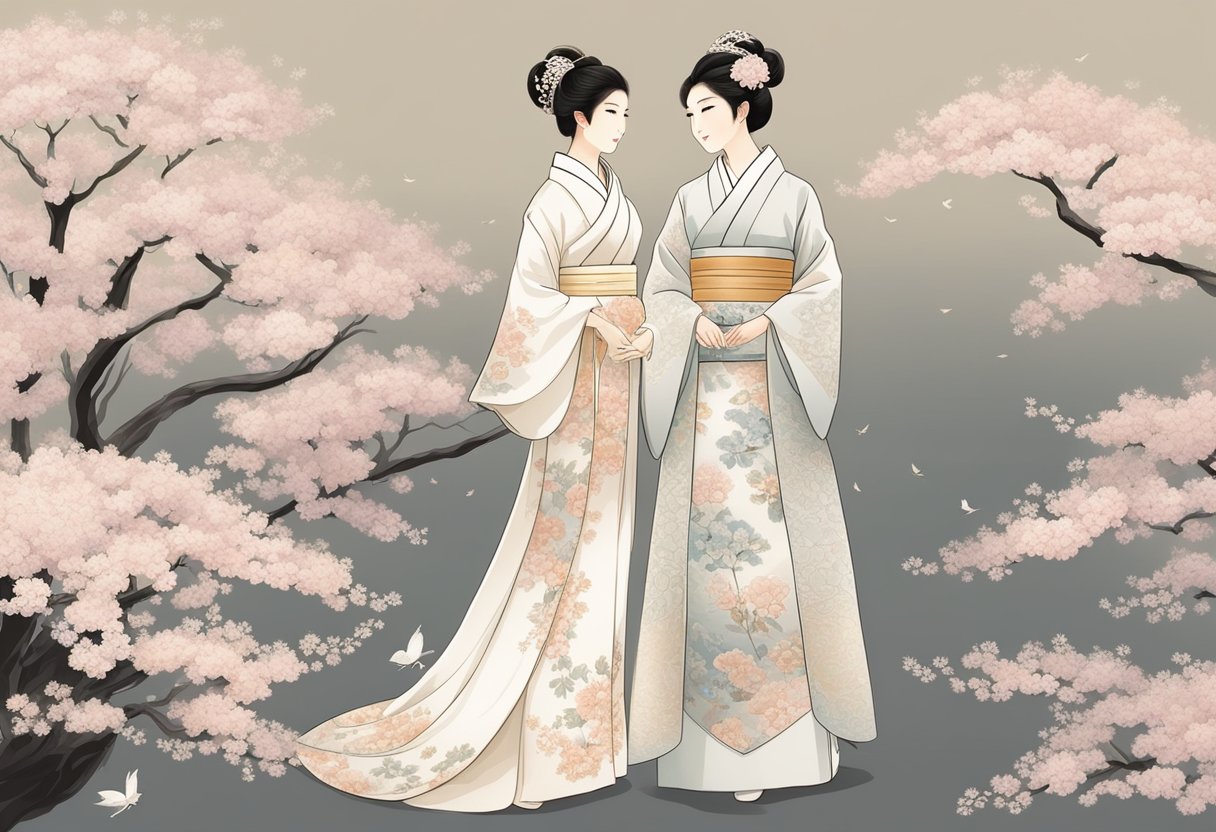
If you’re considering a Japanese wedding dress for your big day, it’s important to understand the key features that make them unique.
Silhouettes
One of the most distinguishable features is its silhouette. Unlike Western wedding dresses, which tend to be form-fitting, the Japanese dresses are typically loose and flowing. They often feature an A-line or ballgown silhouette, which gives them a regal and elegant look.

Sleeves
The wide sleeves are called “furisode“. These sleeves are typically longer than the dress itself and can extend up to 39 inches. The wide sleeves not only add a touch of elegance but also allow for movement and ease of mobility.

Length and Volume
The wedding dressen often feature a long train, which adds to the overall elegance and grandeur of the dress. The volume of the dress is achieved through the use of multiple layers of fabric, which create a full and flowing effect.

Color Significance in Japanese Wedding Dresses
Color plays a significant role in their symbolism. Each color has a specific meaning and significance, which is why it is essential to choose the right color for your wedding dress.
White (Shiromuku)
Traditionally, Japanese brides wear a white wedding dress called Shiromuku. White symbolizes purity, innocence, and a new beginning. The dress is made of silk, and it is a long, flowing robe that covers the entire body. The bride also wears a white hood called a wataboshi, which covers her hair and forehead.

Red (Uchikake)
Red symbolizes good luck, happiness, and prosperity. The Uchikake is a long, heavily embroidered coat that the bride wears over her white wedding dress. The coat is usually red or gold, and it features intricate designs and patterns.

Modern Color Trends
Modern brides have started to experiment with other colors. Some brides opt for pastel colors like pink or blue, while others choose bold colors like black or purple. These colors represent individuality and personal expression.

FAQ
What to wear to a Japanese female wedding?
When attending a Japanese female wedding, consider wearing a formal outfit. Women typically opt for dresses or elegant kimono, but it’s crucial to avoid white or black, reserved for the bride and funerals respectively. Subdued, pastel colors and modest attire are often the best choices.
Who is the famous Japanese wedding dress designer?
One famous Japanese wedding dress designer is Yumi Katsura. She is renowned for her exquisite bridal collections that blend traditional Japanese elements with modern designs. Her creations are sought after by brides around the world for their elegance and craftsmanship.
What is a traditional Japanese wedding like?
A traditional Japanese wedding often includes a Shinto ceremony, where the bride wears a white kimono symbolizing purity and the groom dons a black kimono. Rituals like the exchange of sake cups and sharing of rice wine symbolize unity. The ceremony is followed by a banquet with family and guests.
Do married Japanese wear rings?
Yes, married Japanese couples typically wear wedding rings. The rings are often exchanged during the wedding ceremony, similar to many Western customs. They are worn on the fourth finger of the left hand, signifying the marital bond.
If you liked this blog post about the topic: Japanese Wedding Dress, don’t forget to leave us a comment down below to tell us about your experience with it.
Cinderella Wedding Dresses are more your type? Check out my ideas about it!




